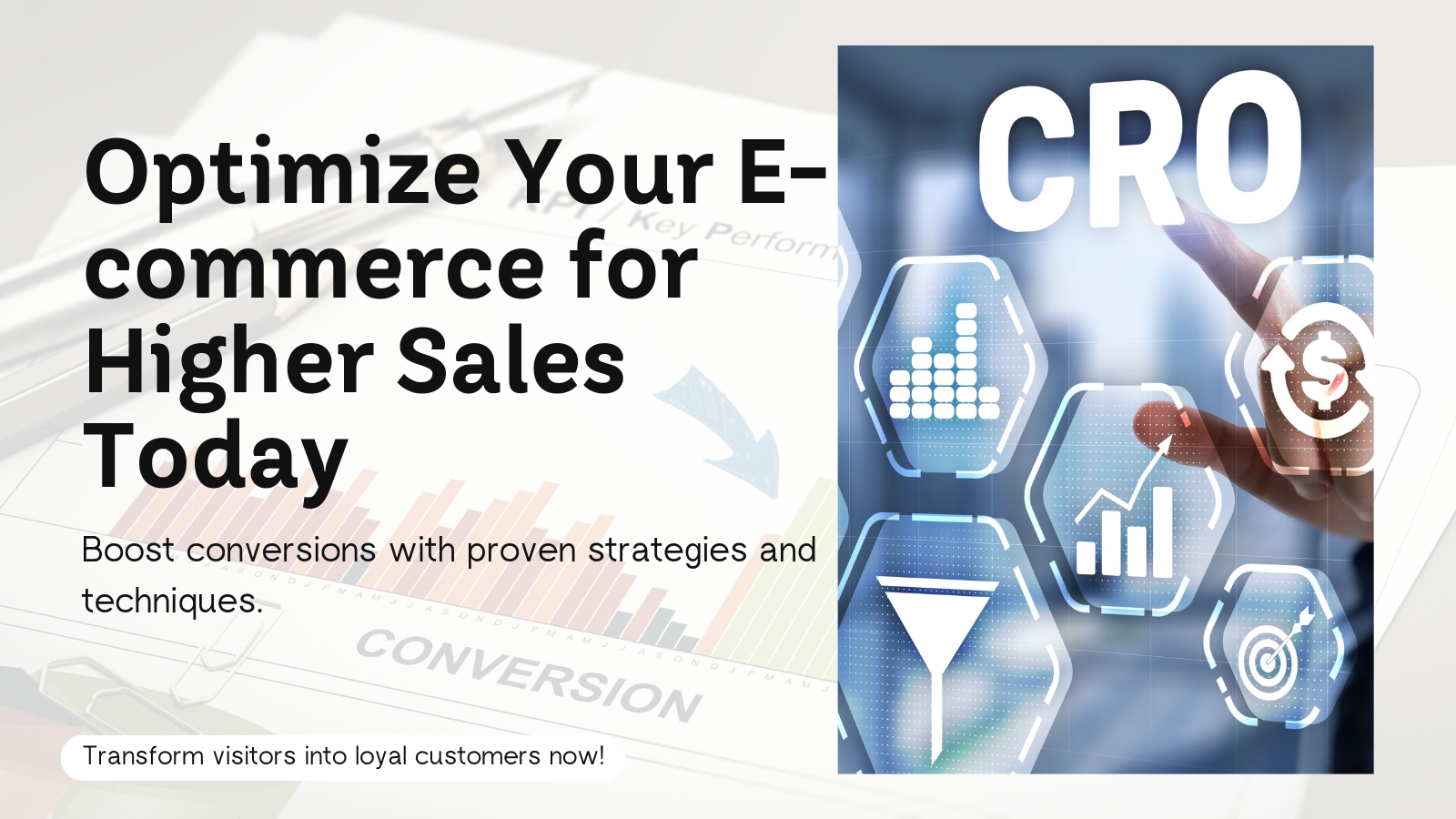
In the rapidly evolving online business world, boosting e-commerce sales is a priority for many companies. With the competition growing daily, it’s not just about attracting traffic to your website; it’s about converting that traffic into actual sales. This is where Conversion Rate Optimization (CRO) becomes crucial. CRO is enhancing a website or landing page experience to increase the percentage of visitors who complete a desired action, such as purchasing. This article will delve into the importance of CRO, its benefits, and effective strategies to optimize your e-commerce site to drive higher sales.
Understanding Conversion Rate Optimization (CRO)
Conversion Rate Optimization (CRO) is a systematic process that focuses on increasing the percentage of website visitors who take a specific desired action. In the context of e-commerce, this action typically involves completing a purchase. CRO consists of understanding how users navigate your site, their actions, and what prevents them from achieving your goals. By analyzing user behavior, businesses can make data-driven decisions to optimize their sites, improving user experience and boosting e-commerce sales.
For e-commerce businesses, CRO is essential to a comprehensive digital sales strategy. Rather than solely focusing on increasing website traffic, CRO aims to maximize the value of existing traffic. This approach ensures that businesses are attracting visitors and converting those visitors into customers, thereby driving growth and increasing revenue.
The Importance of CRO in E-commerce
- Maximizing Revenue from Existing Traffic
One of the primary benefits of CRO is that it allows businesses to maximize revenue from existing traffic. Rather than spending more on advertising and marketing to attract new visitors, CRO focuses on making the most of your visitors. By improving the user experience and making it easier for visitors to complete a purchase, businesses can increase their conversion rates and drive higher e-commerce sales without additional marketing costs.
- Enhancing User Experience
A positive user experience is critical for any e-commerce site. If visitors find your site difficult to navigate, slow to load, or untrustworthy, they are less likely to make a purchase. CRO involves identifying and addressing these pain points to enhance the user experience. By providing a seamless, intuitive, and enjoyable shopping experience, businesses can build customer trust, reduce bounce rates, and increase conversion rates.
- Reducing Customer Acquisition Costs
Customer acquisition can be expensive, especially in the competitive world of e-commerce. By improving conversion rates, businesses can reduce their customer acquisition costs. When more visitors convert into customers, the cost per acquisition decreases, making your marketing efforts more cost-effective. This allows businesses to allocate resources more efficiently and invest in other growth areas.
- Gaining a Competitive Advantage
In a crowded e-commerce market, gaining a competitive advantage is crucial. Businesses prioritising CRO can outperform their competitors by providing a better user experience and converting more visitors into customers. By continuously testing and optimizing their sites, companies can stay ahead of the competition and maintain a strong market position.
Key Strategies for Effective CRO
To boost e-commerce sales with CRO, businesses must implement effective strategies that address the specific needs and behaviors of their target audience. Here are some key strategies for optimizing your e-commerce site to drive higher conversion rates:
- Conduct Thorough A/B Testing
A/B testing, also known as split testing, compares two versions of a web page or element to determine which one performs better. By testing different website versions, you can identify what resonates with your audience and does not. This could involve testing different headlines, images, call-to-action buttons, or complete page layouts. A/B testing allows businesses to make data-driven decisions and implement changes proven to improve conversion rates.
- Optimize Your Website’s Loading Speed
Website loading speed is a critical factor in the user experience and can significantly impact conversion rates. Research shows that a delay of just one second in page load time can lead to a 7% reduction in conversions. To boost e-commerce sales, businesses should optimise their website’s loading speed. This can be achieved by compressing images, leveraging browser caching, and minimizing code, among other techniques.
- Simplify the Checkout Process
A complicated or lengthy checkout process can be a major deterrent for potential customers. To increase conversion rates, businesses should streamline their checkout process, making it as straightforward as possible. This could involve reducing the number of form fields, offering guest checkout options, and providing multiple payment methods. Additionally, businesses should ensure that their checkout process is mobile-friendly, as more consumers are shopping on their mobile devices.
- Improve Product Descriptions and Images
High-quality product descriptions and images are essential for driving e-commerce sales. Clear, detailed descriptions highlighting a product’s features and benefits can help customers make informed purchasing decisions. Similarly, high-quality images showing the product from multiple angles can give customers a better understanding of what they are buying. Businesses can increase customer confidence and encourage more conversions by optimising product descriptions and images.
- Use Social Proof and Trust Signals
Social proof and trust signals play a significant role in influencing purchasing decisions. Customer reviews, testimonials, and ratings can provide potential buyers with the confidence they need to complete a purchase. Additionally, trust signals such as security badges, money-back guarantees, and transparent return policies can help reassure customers that their transactions are safe and secure. By incorporating social proof and trust signals into their e-commerce sites, businesses can build trust with their audience and increase conversion rates.
- Personalize the User Experience
Personalization is a powerful tool for boosting e-commerce sales. By tailoring the shopping experience to individual customers based on their preferences, browsing history, and purchase behavior, businesses can create a more relevant and engaging experience. This could involve personalized product recommendations, targeted promotions, or dynamic content that changes based on the user’s location or behavior. Personalization can help businesses increase customer engagement, reduce bounce rates, and drive higher conversion rates.
- Utilize Remarketing Campaigns
Remarketing, or retargeting, involves targeting users who have previously visited your website but did not complete a purchase. By displaying targeted ads to these users as they browse other sites, businesses can remind them of their products and encourage them to return and complete their purchases. Remarketing campaigns can be highly effective in boosting e-commerce sales, as they target users who have already expressed interest in your products.
- Analyze and Monitor User Behavior
To optimize conversion rates, businesses must deeply understand how users interact with their websites. By analyzing user behavior, companies can identify areas of friction, understand what drives conversions, and make informed decisions about where to focus their optimization efforts. Tools like Google Analytics, heatmaps, and user session recordings can provide valuable insights into user behavior, helping businesses identify opportunities for improvement and drive higher conversion rates.
- Implement Exit-Intent Popups
Exit-intent popups are triggered when a user is about to leave your website. These popups can offer discounts, promotions, or free shipping to encourage users to complete their purchases before leaving. While popups can be intrusive if overused, exit-intent popups can effectively reduce cart abandonment and boost conversion rates when used strategically.
- Continuously Test and Optimize
CRO is an ongoing process that requires continuous testing, analysis, and optimization. Businesses should regularly test different website elements, analyze the results, and implement changes based on data-driven insights. By continuously optimizing their websites, companies can stay ahead of the competition, adapt to changing customer needs, and drive sustained growth in e-commerce sales.
Conclusion
In the competitive world of e-commerce, maximizing sales is about more than just driving traffic to your website. It’s about converting that traffic into paying customers. Conversion Rate Optimization (CRO) is an essential component of a successful digital sales strategy, enabling businesses to maximize the value of their existing traffic, reduce customer acquisition costs, and gain a competitive advantage.
By implementing effective CRO strategies, such as A/B testing, simplifying the checkout process, optimizing product descriptions, and personalizing the user experience, businesses can enhance the user experience, build trust with their customers, and drive higher conversion rates. In doing so, they can boost e-commerce sales, achieve sustainable growth, and secure their position in the market.
Investing in CRO is not just about improving numbers; it’s about understanding your customers, meeting their needs, and delivering a superior online shopping experience. By prioritizing CRO, businesses can create a win-win scenario where customers enjoy a seamless shopping experience, and businesses reap the benefits of increased sales and revenue.

